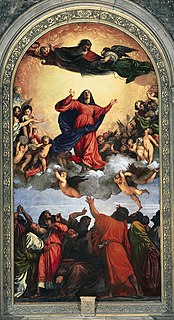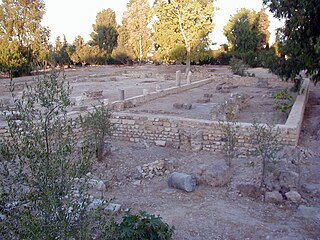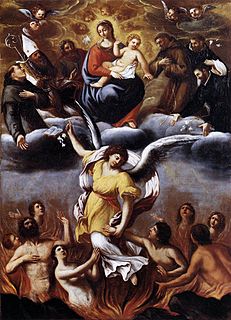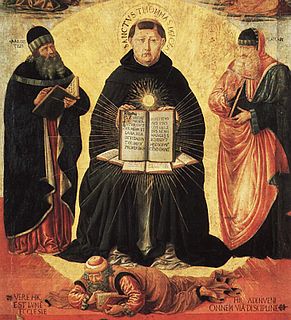 W
WWestern Christianity is one of two sub-divisions of Christianity. Western Christianity is composed of the Latin Church and Protestantism, together with their offshoots such as Independent Catholicism and Restorationism.
 W
WThe Assumption of Mary is, according to the beliefs of the Catholic Church, Eastern Orthodox Churches, Oriental Orthodoxy, Church of the East, and some Anglo-Catholic Churches, among others, the bodily taking up of Mary, the mother of Jesus, into Heaven at the end of her earthly life. The analogous feast in the Eastern Churches is known as the Dormition of the Theotokos.
 W
WThe Athanasian Creed, also called the Pseudo-Athanasian Creed and sometimes known as Quicunque Vult which is both its Latin name and opening words meaning "Whosoever wishes", is a Christian statement of belief focused on Trinitarian doctrine and Christology. The creed has been used by Christian churches since the sixth century. It is the first creed in which the equality of the three persons of the Trinity is explicitly stated. It differs from the Nicene-Constantinopolitan and Apostles' Creeds in the inclusion of anathemas, or condemnations of those who disagree with the creed.
 W
WAugustine of Hippo, also known as Saint Augustine, was a theologian, philosopher, and the bishop of Hippo Regius in Numidia, Roman North Africa. His writings influenced the development of Western philosophy and Western Christianity, and he is viewed as one of the most important Church Fathers of the Latin Church in the Patristic Period. His many important works include The City of God, On Christian Doctrine, and Confessions.
 W
WThe Black Catholic Movement or Black Catholic Revolution was a movement of African-American Roman Catholics which developed and shaped modern Black Catholicism.
 W
WBlack Catholicism or African-American Catholicism comprises the African American people, beliefs, and practices in the Catholic Church.
 W
WCarnival is a Western Christian festive season that occurs before the liturgical season of Lent. The main events typically occur during February or early March, during the period historically known as Shrovetide. Carnival typically involves public celebrations, including events such as parades, public street parties and other entertainments, combining some elements of a circus. Elaborate costumes and masks allow people to set aside their everyday individuality and experience a heightened sense of social unity. Participants often indulge in excessive consumption of alcohol, meat, and other foods that will be forgone during upcoming Lent. Traditionally, butter, milk, and other animal products were not consumed "excessively", rather, their stock was fully consumed as to reduce waste. This festival is known for being a time of great indulgence before Lent, with drinking, overeating, and various other activities of indulgence being performed. For example, Pancakes, donuts, and other desserts were prepared and eaten for a final time. During Lent, animal products are eaten less, and individuals have the ability to make a Lenten sacrifice, thus giving up a certain object or activity of desire.
 W
WThe Archdiocese of Carthage, also known as the Church of Carthage, was a Latin Catholic diocese established in Carthage, Roman Empire, in the 2nd century. Agrippin was the first named bishop, around 230 AD. The temporal importance of the city of Carthage in the Roman Empire had previously been restored by Julius Caesar and Augustus. When Christianity became firmly established around the Roman province of Africa Proconsulare, Carthage became its natural ecclesiastical seat. Carthage subsequently exercised informal primacy as an archdiocese, being the most important center of Christianity in the whole of Roman Africa, corresponding to most of today's Mediterranean coast and inland of Northern Africa. As such, it enjoyed honorary title of patriarch as well as primate of Africa: Pope Leo I confirmed the primacy of the bishop of Carthage in 446: "Indeed, after the Roman Bishop, the leading Bishop and metropolitan for all Africa is the Bishop of Carthage."
 W
WChristian humanism regards humanist principles like universal human dignity, individual freedom, and the importance of happiness as essential and principal or even exclusive components of the teachings of Jesus. Proponents of the term trace the concept to the Renaissance or patristic period, linking their beliefs to the scholarly movement also called 'humanism'.
 W
WThe Immaculate Conception is a dogma of the Catholic Church which states that the Virgin Mary has been free of original sin from the moment of her conception. It proved controversial in the Middle Ages, but was revived in the 19th century and was adopted as Church dogma when Pope Pius IX promulgated Ineffabilis Deus in 1854. This followed Ubi primum, a 1849 encyclical wherein Pius had asked the bishops for their opinions on the matter, resulting in overwhelming support from the Church's hierarchy.
 W
WThe Feast of Corpus Christi, also known as the Solemnity of the Most Holy Body and Blood of Christ, is a Roman Catholic, Anglican, and Western Orthodox liturgical solemnity celebrating the Real Presence of the Body and Blood, Soul and Divinity of Jesus Christ in the elements of the Eucharist. Two months earlier, the institution of the Eucharist at the Last Supper is observed on Maundy Thursday in a sombre atmosphere leading to Good Friday. The liturgy on that day also commemorates Christ's washing of the disciples' feet, the institution of the priesthood and the agony in the Garden of Gethsemane.
 W
WThe Donation of Sutri was an agreement reached at Sutri by Liutprand, King of the Lombards and Pope Gregory II in 728. At Sutri, the two reached an agreement by which the city and some hill towns in Latium were given to the Papacy, "as a gift to the blessed Apostles Peter and Paul" according to the Liber Pontificalis. The pact formed the first extension of papal territory beyond the confines of the Duchy of Rome and was the first of two land transfers from Liutprand to the Church of Rome.
 W
WFilioque is a Latin term added to the original Niceno-Constantinopolitan Creed, and which has been the subject of great controversy between Eastern and Western Christianity. It is a term that refers to the Son, Jesus Christ, as an additional origin point of the Holy Spirit. It is not in the original text of the Creed, attributed to the First Council of Constantinople (381), which says that the Holy Spirit proceeds "from the Father", without additions of any kind, such as "and the Son" or "alone".
 W
WFor about a thousand years, in obedience to interpretations of specific Bible passages, pictorial depictions of God in Western Christianity had been avoided by Christian artists. At first only the Hand of God, often emerging from a cloud, was portrayed. Gradually, portrayals of the head and later the whole figure were depicted, and by the time of the Renaissance artistic representations of God the Father were freely used in the Western Church.
 W
WLamb of God is a title for Jesus that appears in the Gospel of John. It appears at John 1:29, where John the Baptist sees Jesus and exclaims, "Behold the Lamb of God who takes away the sin of the world." It appears again in John 1:36.
 W
WLatin liturgical rites, or Western liturgical rites, are Catholic rites of public worship employed by the Latin Church, the largest particular church sui iuris of the Catholic Church, that originated in Europe where the Latin language once dominated. Its language is now known as Ecclesiastical Latin. The most used rite is the Roman Rite.
 W
WMass is the main Eucharistic liturgical service in many forms of Western Christianity. The term Mass is commonly used in the Catholic Church, and in the Western Rite Orthodox, and Old Catholic churches. The term is used in some Lutheran churches, as well as in some Anglican churches. It is rarely, if ever, used by other Protestant churches, such as in Methodism.
 W
WOriginal sin is the Christian doctrine that humans inherit a tainted nature and a proclivity to sin through the fact of birth. Theologians have characterized this condition in many ways, seeing it as ranging from something as insignificant as a slight deficiency, or a tendency toward sin yet without collective guilt, referred to as a "sin nature", to total depravity or automatic guilt of all humans through collective guilt.
 W
WPapal supremacy is the doctrine of the Catholic Church that the Pope, by reason of his office as Vicar of Christ, the visible source and foundation of the unity both of the bishops and of the whole company of the faithful, and as pastor of the entire Catholic Church, has full, supreme, and universal power over the whole Church, a power which he can always exercise unhindered: that, in brief, "the Pope enjoys, by divine institution, supreme, full, immediate, and universal power in the care of souls."
 W
WPatriarch of the West was on several occasions between AD 450 and 2006 one of the official titles of the bishop of Rome, as patriarch and highest authority of the Latin Church. The title no longer appears among the official ones, starting from the publication of the 2006 Annuario Pontificio.
 W
WPurgatory is, according to the belief of some Christians, an intermediate state after physical death for expiatory purification. There is disagreement among Christians whether such a state exists. Some forms of Western Christianity, particularly within Protestantism, deny its existence. Other strands of Western Christianity see purgatory as a place, perhaps filled with fire. Some concepts of Gehenna in Judaism are similar to that of purgatory.
 W
WThe Holy Roman Empire was a multi-ethnic complex of territories in Western and Central Europe that developed during the Early Middle Ages and continued until its dissolution in 1806 during the Napoleonic Wars. The largest territory of the empire after 962 was the Kingdom of Germany, though it also included the neighboring Kingdom of Bohemia and Kingdom of Italy, plus numerous other territories, and soon after the Kingdom of Burgundy was added. However, while by the end of the 15th century the Empire was still in theory composed of three major blocks – Italy, Germany, and Burgundy – in practice only the Kingdom of Germany remained, with the Burgundian territories lost to France and the Italian territories, ignored in the Imperial Reform, although formally part of the Empire, splintered into numerous de facto independent territorial entities. The external borders of the Empire did not change noticeably from the Peace of Westphalia – which acknowledged the exclusion of Switzerland and the Northern Netherlands, and the French protectorate over Alsace – to the dissolution of the Empire. By then, it largely contained only German-speaking territories, plus the Kingdom of Bohemia, the southern Netherlands and lands of Carniola. At the conclusion of the Napoleonic Wars in 1815, most of the Holy Roman Empire was included in the German Confederation.
 W
WThe Roman Rite is the main liturgical rite of the Latin or Western Church, the largest of the sui iuris particular Churches that make up the Catholic Church. It developed in the Latin language in the city of Rome and, while distinct Latin liturgical rites such as the Ambrosian Rite remain, the Roman Rite has over time been adopted almost everywhere in the Western Church. In medieval times there were very many local variants, even if they did not all amount to distinct rites, but uniformity grew as a result of the invention of printing and in obedience to the decrees of the 1545–1563 Council of Trent. Several Latin liturgical rites that survived into the 20th century were abandoned voluntarily in the wake of the Second Vatican Council. The Roman Rite is now the most widespread liturgical rite not only in the Latin Church but in Christianity as a whole.
 W
WScholasticism was a medieval school of philosophy that employed a critical method of philosophical analysis predicated upon a Latin Catholic theistic curriculum which dominated teaching in the medieval universities in Europe from about 1100 to 1700. It originated within the Christian monastic schools that were the basis of the earliest European universities. The rise of scholasticism was closely associated with these schools that flourished in Italy, France, Spain and England.
 W
WThomism is the philosophical school that arose as a legacy of the work and thought of Thomas Aquinas (1225–1274), philosopher, theologian, and Doctor of the Church. In philosophy, Aquinas' disputed questions and commentaries on Aristotle are perhaps his best-known works.
 W
WThe Vulgate is a late-4th-century Latin translation of the Bible. It was to become the Catholic Church's officially promulgated Latin version of the Bible during the 16th century as the Sixtine Vulgate then as the Clementine Vulgate; the Vulgate is still presently used in the Latin Church.